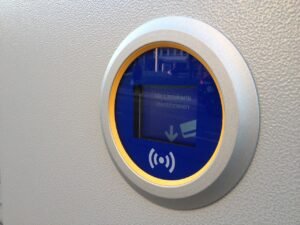Introduction of NFC Technology :
Near Field Communication (NFC) has emerged as a transformative technology, seamlessly integrating into the fabric of our daily lives. In recent years, NFC has gained significant traction, especially within the realm of smartphones. This article delves into the multifaceted use of NFC in smartphones, exploring its evolution, applications, and the impact it has on enhancing user experiences.
Understanding NFC Technology:
NFC is a short-range wireless communication technology that facilitates data exchange between devices over short distances. Operating at a frequency of 13.56 MHz, NFC enables secure and easy communication between devices by bringing them into close proximity. Smartphones equipped with NFC capabilities have become a pivotal driver in the widespread adoption of this technology.
Evolution of NFC in Smartphones:
The inception of NFC in smartphones dates back to the early 2000s, and its integration has evolved significantly since then. Originally designed for contactless payment systems, NFC has diversified its applications to encompass various aspects of our digital lives.
- Contactless Payments: One of the primary applications of NFC in smartphones is enabling contactless payments. With the introduction of mobile payment services like Apple Pay, Google Pay, and Samsung Pay, users can now make transactions by simply tapping their smartphones on NFC-enabled terminals. This not only enhances convenience but also contributes to a more secure and efficient payment ecosystem.
- Data Transfer and Sharing: NFC facilitates seamless data transfer and sharing between smartphones. By tapping two NFC-enabled devices together, users can quickly exchange files, photos, and contact information. This feature eliminates the need for cumbersome pairing processes and makes sharing content a hassle-free experience.
- Access Control and Security: Smartphones with NFC capabilities are increasingly being used for access control and security purposes. This includes unlocking doors, accessing secure locations, and even replacing traditional key cards with virtual credentials stored on the smartphone. The inherent security features of NFC make it a reliable technology for authentication and authorization processes.
- Smart Home Integration: NFC plays a pivotal role in the integration of smartphones with smart home devices. Users can program NFC tags to trigger specific actions when tapped by their smartphones. For instance, tapping the phone on an NFC tag near the entrance could activate or deactivate various smart home devices, providing a personalized and automated home environment.
- Transportation and Ticketing: NFC technology has revolutionized the way we interact with public transportation systems. Many cities have adopted NFC-enabled ticketing systems, allowing users to simply tap their smartphones to access buses, trains, and other modes of transportation. This not only streamlines the commuting experience but also reduces the reliance on physical tickets.
- Healthcare Applications: In the healthcare sector, NFC in smartphones is being leveraged for patient identification, medical record access, and medication management. Healthcare professionals can use NFC-enabled smartphones to quickly access patient information by tapping on secure NFC tags, enhancing efficiency and accuracy in medical settings.
Keyword Focus: Contactless Payments, Data Transfer, Access Control, Smart Home Integration, Transportation, Healthcare Applications.
Impact on User Experiences:
The widespread integration of NFC in smartphones has significantly impacted user experiences across various domains. The emphasis on contactless interactions has not only expedited daily tasks but has also elevated the overall convenience and security of smartphone usage.
- Convenience in Payments: The ability to make secure and swift payments using NFC-equipped smartphones has transformed the way individuals conduct financial transactions. Users no longer need to carry physical wallets or worry about cash; a simple tap with their smartphone is all it takes to complete a purchase.
- Efficient Data Sharing: NFC’s role in enabling quick and effortless data transfer between smartphones has streamlined the sharing of information. Whether it’s sharing photos with friends or exchanging business cards, NFC simplifies the process and enhances interpersonal connectivity.
- Enhanced Security Measures: NFC’s secure communication protocols contribute to enhanced security measures, particularly in access control and authentication. Smartphone users can enjoy a higher level of confidence in the security of their digital identity and personal information.
- Personalized Smart Homes: The integration of NFC in smart homes allows for a personalized and intuitive environment. Users can configure their smartphones to control various devices with a simple tap, creating a seamless and interconnected living space.
- Effortless Commuting: NFC-enabled smartphones have made commuting more efficient and convenient. The ability to use smartphones as tickets for public transportation not only reduces the need for physical cards but also contributes to a smoother and more streamlined travel experience.
- Advancements in Healthcare Services: The utilization of NFC in healthcare applications enhances patient care and facilitates smoother workflows for healthcare professionals. Quick and secure access to patient information contributes to more accurate diagnoses and efficient treatment plans.
Future Prospects:
As NFC technology continues to evolve, its integration with smartphones is expected to further diversify. The future holds exciting possibilities, including advancements in contactless authentication methods, expansion in Internet of Things (IoT) connectivity, and the integration of NFC in emerging technologies like augmented reality.
Conclusion:
The integration of NFC in smartphones has transformed the way we interact with our devices and the world around us. From simplifying payments to enhancing security measures, the multifaceted applications of NFC contribute to a more seamless and connected digital experience. As technology continues to advance, the role of NFC in smartphones is poised to expand, further enriching our daily lives with innovative and convenient solutions.






In these days of austerity as well as relative stress about taking on debt, a lot of people balk contrary to the idea of making use of a credit card in order to make purchase of merchandise as well as pay for a vacation, preferring, instead just to rely on the particular tried along with trusted means of making payment – hard cash. However, if you possess cash available to make the purchase fully, then, paradoxically, that’s the best time for you to use the card for several causes.